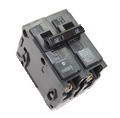» Home Electrical Wiring
» Electrical Wiring Directory
» Circuit Breakers and Fuses
» Need Electrical Help? Ask the Electrician
» Circuit Breakers and Fuses
» Need Electrical Help? Ask the Electrician
Electric Circuit Listing

|
Summary: The size of the home electrical service panel is designed by calculating the square footage of the home and factoring in the code requirements for the electrical circuits that are required.
© By: Dave Rongey |
Electrical Wiring Circuits for a Typical Family Home
This electric circuit listing is based on a single family home of 3000 square foot with the following electrical loads:
|
|||
| 220-3a | General Lighting, 3000 sq ft x 3 watts = 9000 | -- | 1-pole 15 |
| 220-16a | 2 Small Appliance, 1500 ea= 3000 | -- | 1-pole 20 |
| 220-16b | Laundry (Washing Machine) = 1500 | -- | 1-pole 20 |
| T 220-11 | Total General Lighting, Small Appl., Laundry = 13500 | -- | |
| T 220-11 | Apply Demands, 1st 3000 watts | 3000 | |
| T 220-11 | Balance(10500 watts) at 35 percent | 3675 | |
| 220-18 | Dryer (minimum 5k) | 5000 | 2-pole 30 |
| 220-19 | Range (from col C) | 8000 | 2-pole 50 |
| 220-17 | Add Fixed Appliance x 100 percent (not more than four) | 6900 | |
| 220-21 | Larger of Heat / Air Conditioning | 20000 | 2-pole ** |
| VA | Total | 46575 | |
| Amps | Divide by 240 (volts) = | 194 | |
| 310-15(b)6 | 200 Amp service wire: | 2/0 copper | |
15 amp circuit = 1800 watts
20 amp circuit = 2400 watts
Home Electrical Circuits |
|
Additional Electrical Circuits: Note: Smoke Detectors are not required to be on a dedicated circuit. Smoke detectors are typically shared on a lighting circuit such as the hallway lights, this way if the circuit is off for any reason it will be noticed. |
|
The Safest Way to Test Electrical Devices and Identify Electric Wires!The Non-Contact Electrical TesterThis is a testing tool that I have had in my personal electrical tool pouch for years, and is the first test tool I grab to help identify electrical wiring. It is a Non-contact tester that I use to easily Detect Voltage in Cables, Cords, Circuit Breakers, Lighting Fixtures, Switches, Outlets and Wires. Simply insert the end of the tester into an outlet, lamp socket, or hold the end of the tester against the wire you wish to test. Very handy and easy to use.
The Quickest Way to Check for Faulty Electrical Wiring!The Plug-In Outlet TesterThis is the first tool I grab to troubleshoot a problem with outlet circuit wiring. This popular tester is also used by most inspectors to test for power and check the polarity of circuit wiring. It detects probable improper wiring conditions in standard 110-125 VAC outlets Provides 6 probable wiring conditions that are quick and easy to read for ultimate efficiency Lights indicate if wiring is correct and indicator light chart is included Tests standard 3-wire outlets UL Listed Light indicates if wiring is incorrect Very handy and easy to use.
Strip Off Wire Insulation without Nicking and Damaging the Electric Wire!The Wire Stripper and Wire CutterMy absolute favorite wire stripping tool that I have had in my personal electrical tool pouch for years, and this is the tool I use to safely strip electrical wires. This handy tool has multiple uses: The wire gauges are shown on the side of the tool so you know which slot to use for stripping insulation. The end of the tool can be used to grip and bend wire which is handy for attaching wire onto the screw terminals of switches and outlets.. The wire stripper will work on both solid and stranded wire. This tool is Very Handy and Easy to Use. |
||
Residential Electrical Parts and AccessoriesLight Switches 120volt Outlets Circuit Breakers Electrician Tools Voltage Testers |















